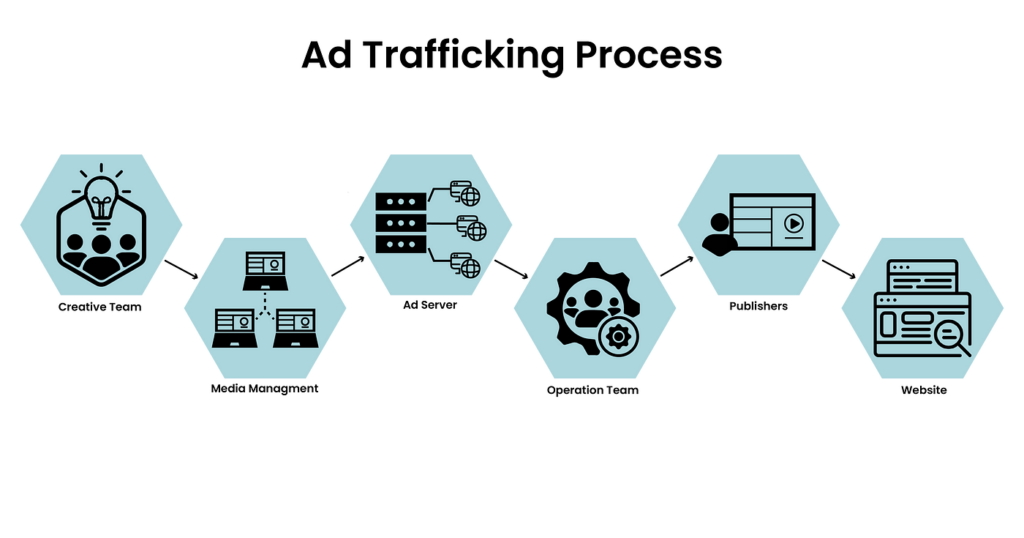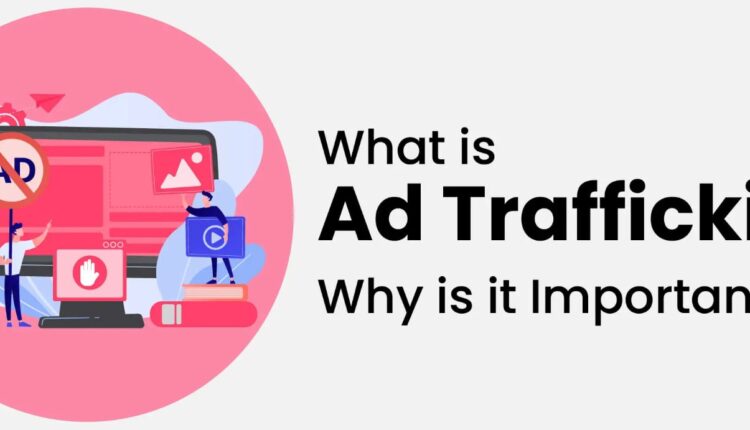Ad trafficking is a crucial process in the world of digital advertising, ensuring that ads are correctly placed and reach the right audience at the right time. Understanding ad trafficking is essential for advertisers, marketers, and businesses looking to maximize the effectiveness of their ad campaigns. This guide will explain what ad trafficking is, its importance, and how to manage it effectively.
1. What is Ad Trafficking?
Ad trafficking refers to the process of setting up, managing, and monitoring online advertising campaigns. It involves coordinating various tasks, such as creating ad creatives, selecting the right platforms, targeting the appropriate audience, and ensuring that ads deliver as planned. It plays a vital role in digital advertising by ensuring that ads are implemented correctly and run smoothly.
2. The Importance of Ad Trafficking
Ad trafficking plays a significant role in the success of advertising campaigns. Here’s why it’s important:
- Ensures Accuracy: Proper ad trafficking ensures that the right format, platforms, and audience display ads correctly. It minimizes errors, such as ads showing up in the wrong places or not appearing at all.
- Maximizes ROI: Efficiently managing ad placements helps ad trafficking optimize ad performance and ensures that the advertising budget achieves the best possible return on investment (ROI).
- Improves User Experience: Properly trafficked ads are less likely to disrupt the user experience, reducing the chances of users being annoyed by irrelevant or poorly placed ads.
- Facilitates Reporting and Analysis: Ad trafficking involves tracking and monitoring ad performance, making it easier to analyze campaign results and make data-driven decisions.
3. The Ad Trafficking Process
The ad trafficking process includes several key steps to set up and manage ads correctly. Here’s a breakdown of the typical ad trafficking workflow:
Step 1: Receiving the Ad Creative
The ad trafficking process begins with receiving the ad creative. This is the visual or textual content that will be displayed to the audience. The ad creative can include images, videos, animations, or text ads. The creative team provides these assets, which are then checked for quality and compliance with platform guidelines.
Step 2: Setting Up the Ad Campaign
Once the ad creative is ready, the next step is setting up the ad campaign. This involves:
- Choosing the Platform: Deciding where the ads will run (e.g., Google Ads, Facebook, Instagram, display networks).
- Targeting the Audience: Defining the target audience based on demographics, interests, behaviors, and other criteria.
- Selecting Ad Formats: Choosing the format of the ads, such as banner ads, video ads, or native ads.
- Setting Budgets and Bids: Allocating the budget for the campaign and setting bid amounts for ad placements.
Step 3: Implementing Ad Tags
Ad tags are snippets of code that help track the performance of ads. These tags are placed on the website or app where the ads will appear. Ad tags collect data such as impressions, clicks, and conversions, providing valuable insights into the effectiveness of the ads.
Step 4: Testing and Quality Assurance
Before launching the ad campaign, it’s essential to test and perform quality assurance checks. This ensures that ads display correctly across different devices and browsers, and also that all tracking codes and links are working properly. Testing helps identify and fix any issues before the ads go live.
Step 5: Launching the Campaign
After testing, the ad campaign is launched. Ads are served to the targeted audience through the chosen platforms. During this phase, the ad trafficker closely monitors the campaign to ensure everything is running smoothly and that there are no technical glitches.
4. Monitoring and Optimizing Ad Campaigns
Ad trafficking doesn’t end with launching the campaign. Continuous monitoring and optimization are crucial for success. Here’s how it’s done:
- Tracking Performance: Use analytics tools to track key metrics such as impressions, clicks, click-through rate (CTR), and conversions. This data helps in understanding how well the ads are performing.
- Analyzing Data: Regularly analyze the collected data in order to identify trends, strengths, and weaknesses. Understanding which ads are performing well and which aren’t can indeed guide future decisions.
- Making Adjustments: Based on the analysis, make necessary adjustments to the ad campaign. This could involve changing the ad creative, tweaking targeting options, adjusting bids, and also reallocating the budget to better-performing ads.
- A/B Testing: Experiment with different versions of ads to see which performs better. A/B testing helps in identifying the most effective ad elements, such as headlines, visuals, and calls to action.
5. Challenges in Ad Trafficking
Ad trafficking comes with its own set of challenges. Some common challenges include:
- Technical Errors: Issues with ad tags, tracking codes, or ad placement can cause ads to display incorrectly or not at all.
- Ad Fraud: Ad fraud, such as fake clicks or impressions, can lead to inaccurate data and wasted budget.
- Compliance: Ensuring that ads comply with the guidelines and policies of different platforms can be challenging, especially with frequent updates to rules and regulations.
- Data Management: Handling large volumes of data and making sense of it can be overwhelming without the right tools and expertise.
6. Best Practices for Ad Trafficking
To manage ad trafficking effectively, consider the following best practices:
- Stay Organized: Keep track of all campaign details, including creatives, targeting settings, and budgets, in order to avoid confusion and errors.
- Use Reliable Tools: Invest in reliable ad trafficking and analytics tools in order to automate tasks and gain deeper insights.
- Regularly Update Knowledge: Stay updated on the latest trends, technologies, and platform policies to ensure compliance and effectiveness.
- Communicate Clearly: Communicate clearly with the creative team, clients, and other stakeholders to align everyone on campaign objectives and expectations.
Conclusion

Ad trafficking is indeed a vital component of digital advertising that requires careful planning, execution, and monitoring. By understanding the ad trafficking process, businesses can ensure their ads reach the right audience, perform well, and further provide a good return on investment. With the right strategies and tools, effective ad trafficking can significantly contribute to the success of advertising campaigns.
Frequently Asked Questions (FAQs)
1. What is ad trafficking?
It is the process of setting up, managing, and monitoring online advertising campaigns in order to ensure they reach the target audience effectively.
2. Why is it important?
It ensures that ads display correctly, reach the right audience, and maximize return on investment by optimizing performance.
3. What tools are commonly in practice?
Common tools used include ad servers, analytics platforms, and ad management software such as Google Ad Manager, Adobe Advertising Cloud, and DoubleClick.
4. How can I optimize my process?
You can optimize your process by regularly monitoring campaign performance, conducting A/B testing, refining audience targeting, and also adjusting budgets based on data insights.


